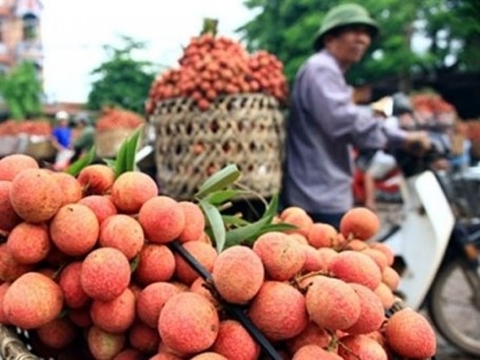
2020 would be the first year Vietnamese lychee entered Japanese market. — Photo tieudung.vn
Viet Nam was getting ready to export lychee to Japan as this harvest season is approaching.
2020 would be the first year Vietnamese lychee enter the Japanese market after Japan gave them the green light in December last year, together with regulations on quarantine for Vietnamese lychee.
Hoang Trung, Director of the Ministry of Agriculture and Rural Development’s Plant Protection Department, said to Viet Nam News Agency that all preparations for the export were nearly completed.
Final evaluation would be carried out soon to ensure successful export of lychee to Japan, Trung said.
According to the Department of Agriculture and Rural Development of Bac Giang Province where lychee was mainly grown in Viet Nam, the northern province developed 19 lychee gardens with a total area of 103 hectares granted codes by the Plant Protection Department and with cultivation complying with Japan’s regulations to be eligible for export to Japan.
Those gardens were located in Luc Ngan District’s Hong Giang, Nam Duong, Tan Son, Quy Son, Giap Son and Ho Dap communes and Tan Yen District’s Phuc Hoa Commune.
Facilities to treat exported lychee with Methyl Bromide as required by Japan were already built in Ha Noi, Bac Giang and Hai Duong, Trung said.
Trung said that the department would continue to work with experts from Japan on lychee quality and treatment before export and packaging.
Due to the COVID-19 pandemic, some final preparations were going slower than expected, as Japanese experts could not travel to Viet Nam.
However, Trung expected that everything for export to Japan would be ready when the peak harvest times for lychee crops came in late May and early June.
Director of Bac Giang Department of Industry and Trade Tran Quang Tuan said that COVID-19 might affect the consumption of lychee this year, especially exports.
Tuan said that China and the domestic market would continue to be major markets for lychee and the province would increase processing and preservation of the fruit.
In the domestic market, Bac Giang would promote sales of lychee at supermarkets and in the southern region.
Lychee plantation areas in Bac Giang totalled more than 28,100 hectares this year with an expected output of 160,000 tonnes. About 14,300 hectares were certified VietGap and 80 hectares GlobalGap together with 200 hectares granted codes for export to the US.
Last year, more than 147,000 tonnes of lychee from Bac Giang were sold with a revenue of VND4.6 trillion.
Hai Duong Province, another lychee hub of Viet Nam with a total plantation area of 9,700 hectares also had 23 gardens granted codes for export to Japan, the US and Australia with a total area of 220 hectares.
As of April 20, three companies registered to take lychee in the province for export to Japan and other markets.
Before Japan, the Vietnamese fresh lychee was exported to several demanding markets such as the US, the EU, and Australia, besides several Asian markets including China, Laos, Cambodia and Thailand. — VNS